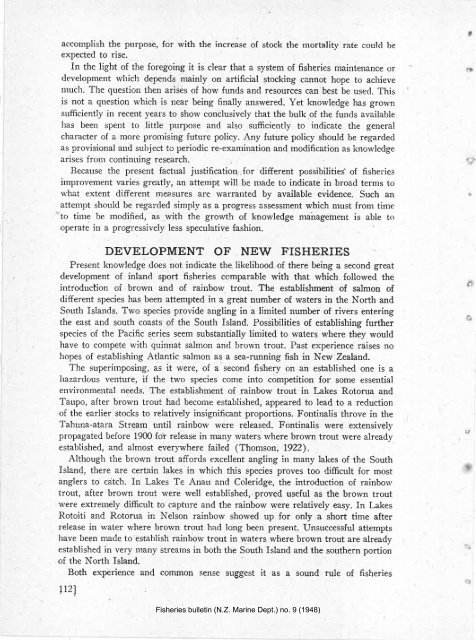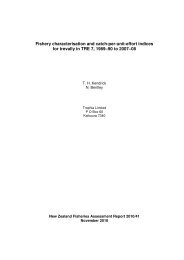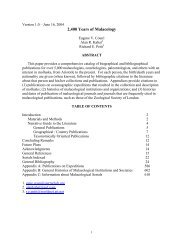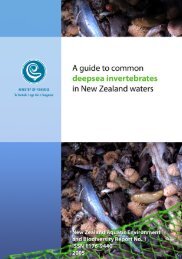N.Z. MARINE DEPARTMENT-FISHERIE,S BULLETIN No. .į
N.Z. MARINE DEPARTMENT-FISHERIE,S BULLETIN No. .į
N.Z. MARINE DEPARTMENT-FISHERIE,S BULLETIN No. .į
Create successful ePaper yourself
Turn your PDF publications into a flip-book with our unique Google optimized e-Paper software.
accomplish the purpose, for with the increase of stock the mortality rate coulcl be<br />
expected to rise.<br />
In the light of tlre foregoing it is clear that a system of fisheries maintenance or<br />
development which clepends mainly on artificial stocking cannot hope to achieve<br />
rnuch. The question then arises of how funds ancl resources can best be used. This<br />
is not a question which is near being finally answered. Yet knowledge has grown<br />
sufficiently in recent years to shorv conclusively that the bulk of the funds available<br />
has been spent to little purpose and also sufficiently to inclicate the general<br />
character of a more promising future policy. Any future policy should be regarclecl<br />
as provisional and subject to periodic re-examination and modification as knowledge<br />
arises from continuing research.<br />
Because the present factual justification for different possibilities of fisheries<br />
improvement varies greatly, an attempt will be made to indicate in broad terms to<br />
u'hat extent different mea"sures are warranted by available evidence. Such an<br />
atter-npt should be regar:cled sirnplv as a progress assessment which must from time<br />
to time be rnoclified, as rvith the growth of knou'ledge mahagement is able to<br />
operate in a progressively less speculative fashion.<br />
DEVELOPMENT OF' NEW <strong>FISHERIE</strong>S<br />
Present knowledge does not indicate the likelihood of there being a second great<br />
clevelopment of inlancl sport fisheries comparable with that which followed the<br />
introduclion of brown and of rainborv trout. The establishment of salmon of<br />
diffe¡ent species has been attempted in a great number of waters in the <strong>No</strong>rth and<br />
South lslancls. Two species provide angling in a limited number of rivers entering<br />
the east and south coasts of the South lsland. Possibilities of establishing further<br />
species of the Pacific series seem substantially limited to waters where they would<br />
have to compete with quinnat salmon ancl brown trout. Past experience raises no<br />
lropes of establishing Atlantic salmon as a sea-running fish in New Zealand.<br />
The superimposing, as it were, of a second fisherv on an established one is a<br />
l-razardous venture, if the two species come into competition for some essential<br />
environmental needs. The establishment of rainbow trout in Lakes Rotorua and<br />
Taupo, after brou'n trout hacl becorne established, appeared to lead to a recluction<br />
of the earlier stocks to relatively insignificant proportions. Fontinalis throve in the<br />
Tahuna-atara Stream until rainbow were releasecl. Fontinalis were extensivell'<br />
propagated before 1900 for release in many waters where brown trout ü/ere already<br />
established, and almost everywhere failed (Thomson, 1922).<br />
Although the brown trout affords excellent angling in tnany lakes of the South<br />
Island, there are certain lakes in which this species proves too difficult for most<br />
anglers to câtch. In Lakes Te Anan ancl Coleridge, the introduction of rainbou'<br />
trout, after brown trout were well established,.proved useful as the brown trout<br />
were extrernely difficult to capture and the rainbow were relatively easy. In Lakes<br />
Rotoiti and Rotorua in Nelson rainbow showed up for only a short time after<br />
release in water where brown trout had long been present. IJnsuccessful attempts<br />
have been made to establish rainbow trout in waters where brown trotrt are alreacly<br />
established in very many streams in both the South Island and the southern portion<br />
of the <strong>No</strong>rth Island.<br />
Both experience and common sense suggest it as a sound rule of fisheries<br />
tt2l<br />
Fisheries bulletin (N.Z. Marine Dept.) no. 9 (1948)<br />
¿-.







